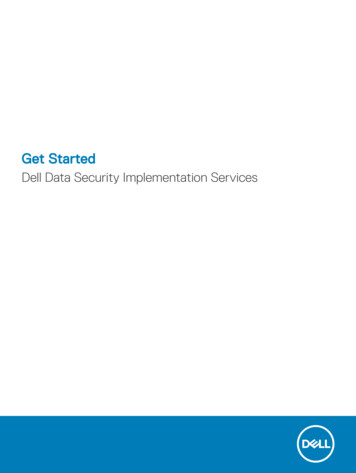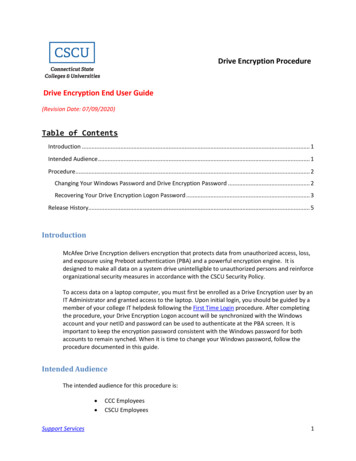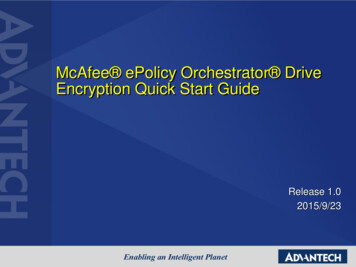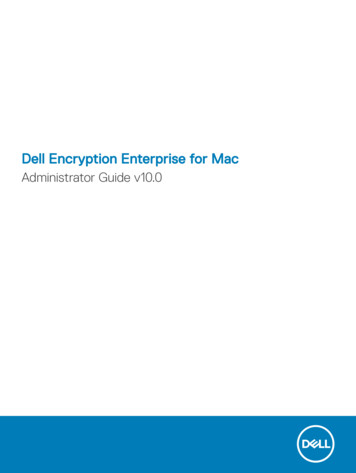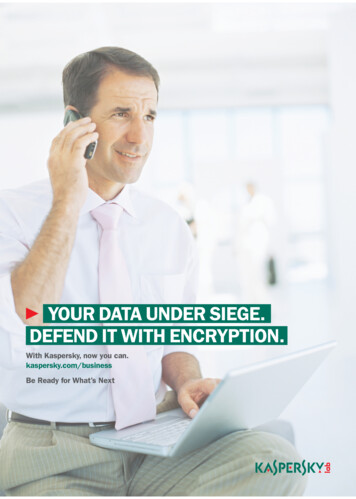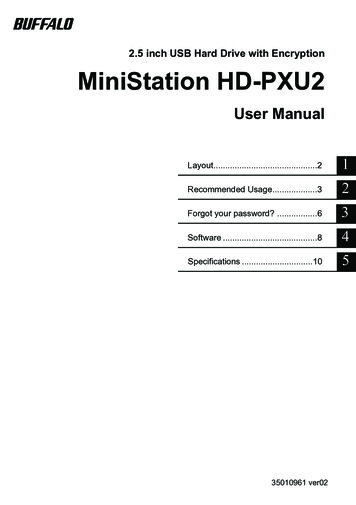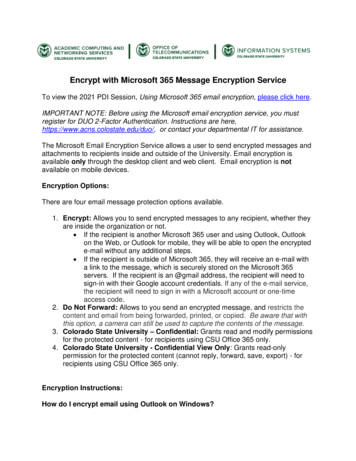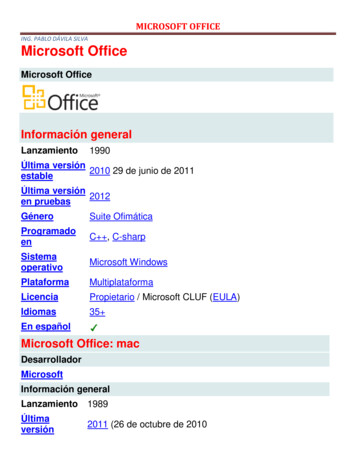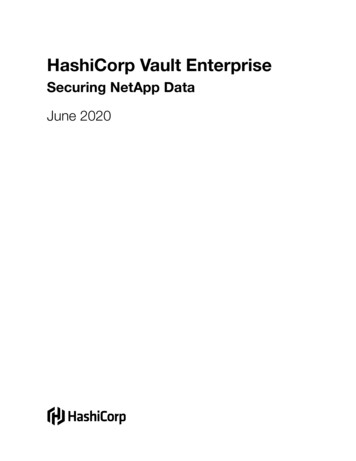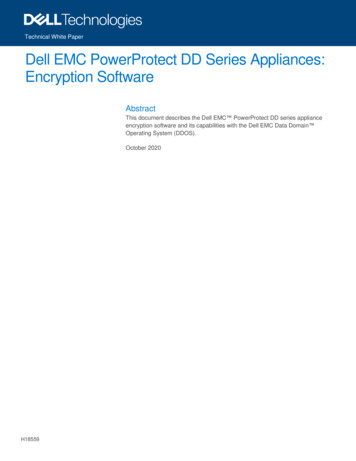
Transcription
Content Encryption inMicrosoft Office 365Published: January 23, 2017This document provides an overview of the various encryption technologies that arecurrently available or recently announced for Office 365, including features deployedand managed by Microsoft and by customers 2017 Microsoft Corporation. All rights reserved. This document is provided "as-is." Information and views expressed in this document, including URL and other Internet Web sitereferences, may change without notice. You bear the risk of using it. Some examples are for illustration only and are fictitious. No real association is intended or inferred. This documentdoes not provide you with any legal rights to any intellectual property in any Microsoft product. You may copy and use this document for your internal, reference purposes.
Document Location: http://aka.ms/Office365CEDocument Feedback: cxprad@microsoft.comP a g e 1ContentsIntroduction . 2Encryption of Customer Content at Rest . 2Volume-level Encryption . 2File-Level Encryption. 4Skype for Business . 4SharePoint Online and OneDrive for Business . 5List Items in SharePoint Online . 6Mailbox-Level Encryption . 6Example Scenario for Mailbox-Level Encryption in Exchange Online with a Customer ManagedKey. 8Key Management . 9Exiting the Office 365 Service . 10Encryption of Customer Content In-transit . 10Customer-managed Encryption Technologies . 11Azure Rights Management . 11Secure Multipurpose Internet Mail Extension . 13Office 365 Message Encryption. 13Transport Layer Security . 13Risks and Protection . 13Office 365 Multi-tenant . 15Office 365 Government Community Cloud . 17Summary . 19Materials in this Library.20
Document Location: http://aka.ms/Office365CEDocument Feedback: cxprad@microsoft.comP a g e 2IntroductionCustomer content within Microsoft Office 365 is protected by a variety of technologies and processes,including various forms of encryption. Microsoft uses service-side technologies in Office 365 thatencrypt customer content1 at rest and in-transit. For content at rest, Office 365 uses volume-level andfile-level encryption. For content in-transit, Office 365 uses multiple encryption technologies, such asTransport Layer Security (TLS) and Internet Protocol Security (IPsec). Office 365 also includesadditional encryption options that are customer-managed, but irrespective of customer configuration,customer content stored within Office 365 is protected. Validation of our crypto policy and itsenforcement is independently verified through the multiple third-party auditors.In accordance with the Public Key Infrastructure Operational Security Standard, which is a componentof Microsoft Security Policy, Office 365 leverages the cryptographic capabilities that are directly a partof the Windows Operating System for certificates and authentication mechanisms (e.g. Kerberos).Office 365's FIPS 140-2 cryptographic modules used for transmitted information are certified by theNational Institute of Standards and Technology (NIST). Relevant NIST certificate numbers for Microsoftcan be found at -1/1401vend.htm. Any timecryptographic capabilities are employed to protect the confidentiality, integrity, or availability of datawithin Office 365, the modules and ciphers used are FIPS 140-2 validated.Encryption of Customer Content at RestEncryption of Office 365 customer content at rest is provided by multiple service-side technologies:BitLocker volume-level encryption for Office 365 servers, and file-level encryption in Skype forBusiness, OneDrive for Business and SharePoint Online. In addition, Microsoft is adding capabilities toExchange Online known as Mailbox-Level Encryption.Volume-level EncryptionOffice 365 servers use BitLocker to encrypt the disk drives containing log files and customer contentat rest at the volume-level. BitLocker encryption is a data protection feature that is built into Windows.BitLocker is one of the technologies used to safeguard against threats in case there are lapses in otherprocesses or controls (e.g., access control or recycling of hardware) that could lead to someonegaining physical access to disks containing customer content. In this case, BitLocker eliminates thepotential for data theft or exposure because of lost, stolen, or inappropriately decommissionedcomputers and disks.BitLocker is deployed with Advanced Encryption Standard (AES) 256-bit encryption on diskscontaining customer content in Exchange Online, SharePoint Online, and Skype for Business. Disksectors are encrypted with a Full Volume Encryption Key (FVEK), which is always encrypted with theVolume Master Key (VMK), which, in turn, is bound to the Trusted Platform Module (TPM) in theserver. The VMK directly protects the FVEK and therefore, protecting the VMK becomes critical. The1Exchange Online mailbox content (e-mail body, calendar entries, and the content of e-mail attachments), SharePoint Online site contentand the files stored within sites, and files uploaded to OneDrive for Business.
Document Location: http://aka.ms/Office365CEDocument Feedback: cxprad@microsoft.comP a g e 3following figure illustrates an example of the BitLocker key protection chain for a given server (in thiscase, an Exchange Online server).Figure 1 - BitLocker Protection Chain for Exchange Online serversThe following table describes the BitLocker key protection chain for a given server (in this case, anExchange Online server).KEY PROTECTORGRANULARITYHOW GENERATED?WHERE IS ITPROTECTIONSTORED?AES 256-bit External KeyPer ServerBitLocker APIsTPM or SecretLockbox / Access ControlSafeMailbox ServerTPM encryptedRegistry48-digit Numerical PasswordPer DiskBitLocker APIsActive DirectoryLockbox / Access ControlX509 Certificate as DataEnvironment (e.g.,Microsoft CABuild SystemNo one user has the full password toRecovery Agent (DRA) alsoExchange Onlinethis certificate. The password is undercalled Public Key Protectormultitenant)physical protection.Table 1 – BitLocker Protection Chain for Exchange Online ServersBitLocker key management involves the management of recovery keys that are used tounlock/recover encrypted disks in an Office 365 datacenter. Office 365 stores the master keys in asecured share, only accessible by individuals who have been screened and approved. The credentialsfor the keys are stored in a secured repository for access control data (what we call a “secret store”),which requires a high level of elevation and management approvals to access using a just-in-timeaccess elevation tool. All elevated access is both approved and logged by a group other than thegroup requesting access.BitLocker supports keys which generally fall into two management categories:
Document Location: http://aka.ms/Office365CEDocument Feedback: cxprad@microsoft.comP a g e 4BitLocker-managed keys, which are generally short-lived and tied to the lifetime of anoperating system instance installed on a server or a given encrypted disk. These keys aredeleted and reset during server reinstallation or disk formatting. BitLocker recovery keys, which are managed outside of BitLocker but used for disk decryption.BitLocker uses recovery keys for the scenario in which an operating system is reinstalled, andencrypted data disks already exist. Recovery keys are also used by Managed Availabilitymonitoring probes for BitLocker in Exchange Online where a responder may need to unlock adisk.BitLocker-protected volumes are encrypted with a full volume encryption key, which in turn isencrypted with a volume master key. BitLocker uses Federal Information Processing Standards (FIPS)compliant algorithms to ensure that encryption keys are never stored or sent over the wire in theclear.2 The following list of requirements have been validated for BitLocker: Cryptographic Module Specification (Section 2 of Spec)Cryptographic Module Ports and Interfaces (Section 2 & 4 of Spec)Finite State ModelOperational Environment (Section 6.1.2, Item 3 & 4)Design AssuranceMitigation of Other AttacksSelf-Tests (Section 8)Because the Office 365 implementation of customer content-at-rest-protection does not deviate fromthe default BitLocker implementation, the deployment of BitLocker in Office 365 is FIPS 140 Level 2validated, and meets these requirements by default.File-Level EncryptionIn addition to using volume-level encryption, Skype for Business, SharePoint Online, and OneDrive forBusiness also use file-level encryption.Skype for BusinessIn Skype for Business, customer content at rest may be stored in the form of files or presentations thathave been uploaded by meeting participants. The Web Conferencing server encrypts content usingAES with a 256-bit key. The encrypted content is stored on a file share. Each piece of content isencrypted using a different randomly generated 256-bit key. When a piece of content is shared in aconference, the Web Conferencing server instructs the conferencing clients to download theencrypted content via HTTPS. It sends the corresponding key to clients so that the content can bedecrypted. The Web Conferencing server also authenticates conferencing clients before it allows theclients access to conference content. When joining a Web conference, each conferencing clientestablishes a SIP dialog with the conferencing focus component running inside the front-end serverover TLS first. The conferencing focus passes to the conference client an authentication cookieTo be to FIPS 140-2 compliant, a cryptographic module must satisfy all the security requirements specified by the FIPS 140-2 standard. Inother words, FIPS 140-2 compliance does not dictate which drives/volumes need to be encrypted; rather it only requires that encryptedvolumes must conform to FIPS 140-2 standards. The security requirements for FIPS 140-2 are described in the spec released by NIST.2
Document Location: http://aka.ms/Office365CEDocument Feedback: cxprad@microsoft.comP a g e 5generated by the Web Conferencing server. The conferencing client then connects to the WebConferencing server presenting the authentication cookie to be authenticated by the server.SharePoint Online and OneDrive for BusinessAll customer content in SharePoint Online is protected by unique, per-file keys that are alwaysexclusive to a single tenant. When a file is uploaded, encryption is performed by SharePoint Onlinewithin the context of the upload request, before being sent to Azure storage. When a file isdownloaded, SharePoint Online retrieves the encrypted content from Azure storage based on theunique document identifier, and decrypts the content before sending it to the user. Azure storage hasno ability to decrypt, or even identify or understand the content. All encryption and decryptionhappens in the same systems that enforce tenant isolation, which are Azure Active Directory andSharePoint Online.In SharePoint Online, all content that a customer uploads is encrypted (potentially with multiple AES256-bit keys) and distributed across the datacenter as follows:3 Each file is broken into one or more chunks, depending on file size. Each chunk is encryptedusing its own unique key.When a file is updated, the update is handled in the same way: the change is broken into oneor more chunks, and each chunk is encrypted with a separate unique key.These chunks – files, pieces of files, and update deltas – are stored as blobs in Azure storagethat are randomly distributed across multiple Azure storage accounts.The set of encryption keys for these chunks of content is itself encrypted using anindependently-generated master key.o The encrypted keys are stored in the SharePoint Online Content Database.o The master key to decrypt the keys to the shreds is stored in a separate securerepository called the Key Store.The map used to re-assemble the file is stored in the SharePoint Online Content Databasealong with the encrypted keys, separately from the master key needed to decrypt them.Each Azure storage account has its own unique credentials per access type (read, write,enumerate, and delete). Each set of credentials is held in the secure Key Store and is regularlyrefreshed.As described above, there are three different types of stores, each with a distinct function: 3Content is stored as encrypted blobs in Azure storage. The key to each chunk of content isencrypted and stored separately in the Content Database. The content itself holds no clue asto how it can be decrypted.The Content Database is a SQL Server database. It holds the map required to locate andreassemble the content blobs held in Azure storage as well as the keys needed to encryptthose blobs. However, the set of keys is itself encrypted. The master key is held in a separateKey Store.Every step of this encryption is FIPS 140-2 Level 2 validated.
Document Location: http://aka.ms/Office365CEDocument Feedback: cxprad@microsoft.com P a g e 6The Key Store is physically separate from the Content Database and Azure storage. It holdsthe credentials for each Azure storage container and the master key to the set of encryptedkeys held in the Content Database.Each of these three storage components – the Azure blob store, the Content Database, and the KeyStore – is physically separate. The information held in any one of the components is unusable on itsown. Without access to all three, it is impossible to retrieve the keys to the chunks, decrypt the keys tomake them usable, associate the keys with their corresponding chunks, decrypt each chunk, orreconstruct a document from its constituent chunks.The master keys, which protect the per-blob keys, are stored in two locations: First, a secure repository (the SharePoint Online secret store), which is protected by the FarmKey.Second, the master keys are backed-up in the central SharePoint Online secret store.Currently, these keys are updated (and the blob keys re-encrypted) every 42 days. The credentialsused to access the Azure storage containers are also held in the central SharePoint Online secretstore, and delegated to each SharePoint Online farm as needed. These credentials are Azure storageSAS signatures, with separate credentials used to read or write data, and with policy applied so thatthey auto-expire every 60 days. Different credentials are used to read or write data (not both) andSharePoint Online farms are not given permissions to enumerate.Note For Office 365 Government customers, data blobs are stored in Azure GovernmentStorage. In addition, access to SharePoint Online keys in Office 365 Government is limited toOffice 365 staff has have been specifically screened. Azure Government operations staff donot have access to the SharePoint Online key store that is used for encrypting data blobs.For more information about data encryption in SharePoint Online and OneDrive for Business, seeData Encryption in OneDrive for Business and SharePoint Online.List Items in SharePoint OnlineList Items are smaller chunks of content that are created ad-hoc or that can live more dynamicallywithin a site, such as rows in a user-created list, individual posts in a SharePoint Online blog, or entrieswithin a SharePoint Online wiki page.List item contents are encrypted at rest by BitLocker drive encryption, which is enabled on all theback-end and storage servers used by SharePoint Online.Mailbox-Level EncryptionOne of the security principles used by Microsoft in the defense of its cloud services and datacenters isAssume Breach – the idea that every component or compartment of a computing system will at somepoint be compromised by a malicious actor. Assume Breach is a concept that guides securityinvestments, design decisions and operational security practices within Office 365 and all Microsoft
Document Location: http://aka.ms/Office365CEDocument Feedback: cxprad@microsoft.comP a g e 7cloud services. For more information about how Microsoft leverages the Assume Breach mindset, seeSecurity Incident Management in Microsoft Office 365. Microsoft’s Assume Breach mindset includesWindows administrator accounts and therefore suggests that if some compartmentalization of dataaccess from server administrative access is possible then it should be considered. This conceptualmodel extends into the realm of data encryption because BitLocker is tied to the Windows accesscontrol model and allows an administrator to configure BitLocker, and even disable BitLocker.BitLocker also does not protect data that is copied or moved from an encrypted disk volume tostorage media that does not use BitLocker.More importantly, BitLocker precludes “bring your own key” (BYOK)4 scenarios that operate at thevolume level. BitLocker is a full volume encryption technology that uses a common key across data onthe same storage volume. This means that a disk volume that contains data from more than onecloud service tenant would use the same encryption key, thereby precluding scenarios in which atenant controls encryption keys. To mitigate this threat, Microsoft has compensating controls thatprevent any unauthorized copying of data within the service.To overcome these limitations and enable tenant control and management of encryption keys,Microsoft is adding a feature to Exchange Online known as Mailbox-Level Encryption5 that includes aBYOK option. The scope for Mailbox-Level Encryption is all customer content6 that is stored at restwithin Exchange Online.7Mailbox-Level Encryption provides multiple benefits. For example, it: Enables multi-tenant services to provide per-tenant key management.Provides separation of Windows operating system administrators from access to customercontent stored or processed by the operating system.Provides customers with a mechanism for rendering all customer content inaccessible toOffice 365 services upon leaving Office 365.Enhances the ability of Office 365 to meet the demands of customers that have requirementsregarding encryption.The implementation of Mailbox-Level Encryption within the Exchange Online application is intendedto address the risks and functional limitations of BitLocker. Providing customers with a method tocontrol key material used in the encryption of customer content provides a robust and desirablemechanism for providing customers with the assurance that should the customer choose to leave theOffice 365 service that Microsoft will not have continued access to the customer’s content. Acustomer that revokes access to their key material will be able to render all content held within OfficeBYOK refers to a method for managing encryption keys which can be applied to several of the technologies discussed in this document.Previously referred to as Advanced Encryption. See Enhancing transparency and control for Office 365 customers for announcement.6For Exchange Online, all customer content includes everything that an end user generates and stores in their mailbox, including calendaritems, notes, tasks, folders, etc. in addition to email messages. For SharePoint Online, this means files.7Skype for Business stores nearly all user-generated content within the user’s Exchange Online mailbox and therefore inherits the MailboxLevel Encryption feature of Exchange Online as it becomes available.45
Document Location: http://aka.ms/Office365CEDocument Feedback: cxprad@microsoft.comP a g e 8365 unreadable by the cloud service. This is in addition (and a complement) to the Customer Lockboxfeature that can be used to control access to customer content by cloud service personnel.Example Scenario for Mailbox-Level Encryption in Exchange Online with a CustomerManaged-KeyContoso is an Office 365 customer that has elected to use Mailbox-Level Encryption in ExchangeOnline with a Contoso-managed encryption key. To do this:1.2.3.4.5.6.The Tenant Admin logs into the Contoso Azure subscription to configure encryption keys inAzure Key Vault.The Tenant Admin creates one or more key vaults in their Azure subscription and thenimports keys in each key vault using the BYOK toolset; or the Tenant Admin requests a keyfrom Azure Key Vault.The Tenant Admin configures access control using the Azure PowerShell cmdlet SetAzureKeyVaultAccessPolicy on the key vaults to allow Exchange Online to perform keywrap/unwrap functions.8The Tenant Admin creates a data encryption policy for use with Exchange Online mailboxesusing the New-DataEncryptionPolicy cmdlet in Remote PowerShell. This data encryptionpolicy will include the URI of the Azure Key Vault key that is to be used with mailboxes thatthe customer assigns to that encryption key policy. Creation of the encryption policy withinOffice 365 provides the core information required to validate and begin using the keyreferenced in the policy.The Tenant Admin uses the Set-Mailbox cmdlet to assign the data encryption policy to one ormore Exchange Online mailboxes.Once Office 365 has validated proper configuration of a key policy the service will enable theTenant Admin to assign objects (mailboxes in the case of Exchange Online) to that key policy.The following illustration shows the process described above.See 78079.aspx for the operations available for keys mt620025.aspx for setting permissions on key vaults.8
Document Location: http://aka.ms/Office365CEDocument Feedback: cxprad@microsoft.comP a g e 9Figure 2 - Enabling Mailbox-Level Encryption with customer-managed keysAn optional step will be to generate or upload multiple keys (not a single key in multiple key vaults)for use with Exchange Online resources, and to create additional encryption key policies for use withthose keys. This will allow a tenant to choose, as one example, to assign a key policy that points to anAzure Key Vault key that is held in Europe for resources that are also located in Europe, while using asecond key policy that points to an Azure Key Vault key that is held in the United States for resourcesthat are in the United States.It is expected that every tenant will have a default encryption policy key. For customers that do notchoose to own and manage encryption keys, the default policy key will be used to encrypt customercontent. If the customer starts using their own encryption key at some point in the future, the act ofassigning a data encryption policy (DEP) to service resources would result in the service re-wrappingthe existing keys using the newly assigned DEP.Key ManagementThere are two scenarios that may require additional key management tasks:1.You want to stop using an existing key vault that has an associated DEP. In this scenario, youwould create a new DEP and assign it to all users.2. You want to roll the key in the key vault. In this scenario, you would create a new key within,or import a key into, the key vault containing the existing key, perform the process describedin Example Scenario for Mailbox-Level Encryption with Customer-Managed Key, and thenenable the newly configured key for use by using the Set-DataEncryptionPolicy cmdlet.
Document Location: http://aka.ms/Office365CEDocument Feedback: cxprad@microsoft.comP a g e 10When you choose to manage your own key, you control the key that lets Microsoft services decryptyour data. If you delete your key from Azure Key Vault, Office 365 services will eventually lose theability to function with your data. Microsoft cannot recover your deleted key. To help protect keysmanaged by your organization, we recommend following these best practices: Never purge your keys; only revoke access and only if need be. Removal of a root key withoutensuring that 100% of data encryption has been switched to your new key will result inpermanent data loss.Ensure that you minimize who has permissions to manage your key vault.Ensure that your personnel are trained properly.Lock your key vault.Keep an offline backup of your key just in case your key administrator makes a mistake.Exiting the Office 365 ServiceOne of the benefits that Office 365 customers get from using Mailbox-Level Encryption with acustomer-managed key is the ability to leave Office 365 and remove access to the encryption keyused to encrypt the customer’s content, thus rendering all customer content held in Exchange Onlineinaccessible.The design for the process of removing access to an encryption key is still under review. Becauserevocation of access to a key will have major and potentially irreversible effects upon the ability todeliver the affected service(s), Microsoft reserves the right to control when revocation will be honoredto allow action to be reversed (in case of mistake, rogue admin, etc.) within a predetermined time.Encryption of Customer Content In-transitIn addition to protecting customer content at rest, Office 365 uses encryption technologies to protectcustomer content in-transit. Data is in-transit when a client machine communicates with an Office 365server, when an Office 365 server communicates with another Office 365 server, or when an Office365 server communicates with a non-Office 365 (e.g., Exchange Online delivering email to a foreignemail server). Inter-datacenter communications between Office 365 servers takes place over
Table 1 - BitLocker Protection Chain for Exchange Online Servers BitLocker key management involves the management of recovery keys that are used to unlock/recover encrypted disks in an Office 365 datacenter. Office 365 stores the master keys in a secured share, only accessible by individuals who have been screened and approved. The credentials


